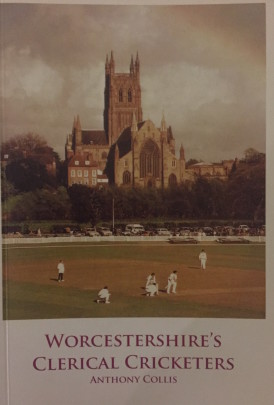Worcestershire’s Clerical Cricketers
Martin Chandler |Published: 2019
Pages: 44
Author: Collis, Anthony
Publisher: Collis, Anthony
Rating: 3.5 stars

Anthony Collis is the secretary of the Stourbridge and District Cricket Society, and a very active one from what I can see. There are cricket societies all over the country, but judging by web sites alone that in Stourbridge is the most impressive. Collis has a pedigree as a writer as well, having self-published the excellent Fostershire a couple of years ago.
This excellent booklet arose out of a talk that Collis himself gave last year. When he got around to researching what he thought would be a relatively small area of the history of Worcestershire cricket he discovered that he had much more material than could be accommodated within what amounted to a lecture, hence his decision to publish the result of his efforts.
After a short introduction the start of the story, unsurprisingly given all the circumstances, is a brief tribute to the father of the famous brotherhood, Rev’d Henry Foster who, although not a First Class cricketer himself was, via the agency of his children in his own way largely responsible for Worcestershire becoming a First Class county in the first place.
The larger part of the booklet then goes on to paint pen portraits of a total of twenty clerics who contributed to the history of the county club. Foster appears again here, as do as many as four members of the Lyttelton family, albeit not the best known of them. Wicketkeeper Alfred who, in his fourth and final Test against Australia took off his pads and took four wickets with his lobs, played for Middlesex, but two of his brothers feature in Worcestershire’s Clerical Cricketers.
None of the men featured in the twenty were notable cricketers, but I had heard of three of them. Collis tells the story of RH Moss who, at 57, is and surely will always remain the oldest man to make a County Championship debut. Also familiar was the name of WR Chignell, who wrote two books on the history of the county, and that of Mike Vockins, long serving secretary of the county and another published author. Vockins is one of only two men featured in the book who are still with us.
Having not to this point dealt with anyone with a significant playing career Collis then allows himself a digression in order to include a couple of quality cricketers, both of whose fathers were, at least at some point, men of the cloth in Worcestershire. The first is George Chesterton, a fine medium pace bowler whose teaching commitments restricted him to just 45 Championship appearances in seven summers for Worcestershire. Second, and the other survivor, is a man who needs no introduction, the great Sussex and England fast bowler John Snow.
The book concludes with a few pages on the Gillingham family. GW Gillingham is one of the twenty and he was the cousin of the man who, with a bit more luck, might have been the only England cricketer to have been born in Japan. Canon Frank H Gillingham was a classy batsman who first turned out for Essex in 1903 and last played for the county a quarter of a century later, albeit his regular appearances ended several years before that. Also reproduced is the text of an address by GW on the occasion of a church service in 1935 to mark the centenary of the Hagley club.
Worcestershire’s Clerical Cricketers is a most enjoyable little book and is highly recommended. Although not a limited edition as such I do know there was a very small print run, so I would suggest that anyone interested in obtaining a copy seeks to do so through the Society’s website at their earliest opportunity.







Leave a comment